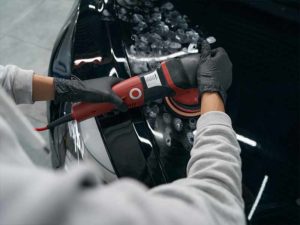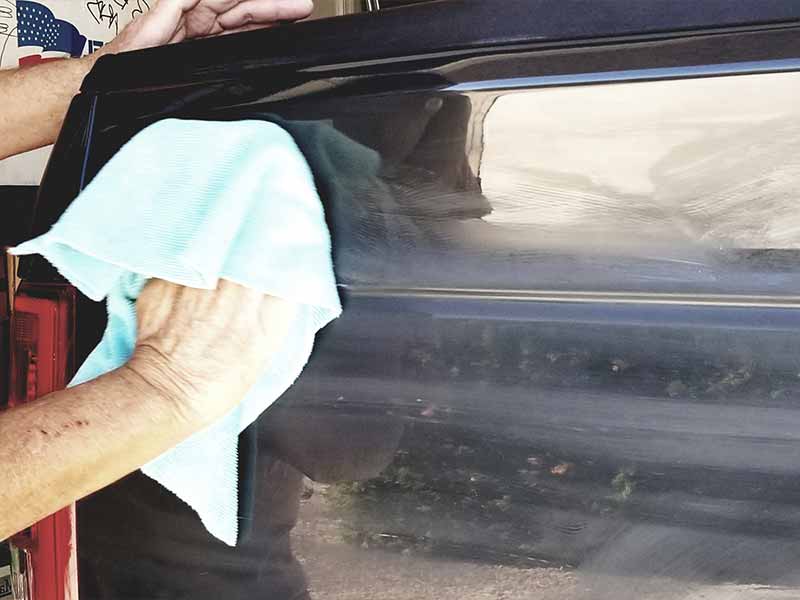Table of Contents
- How Thick Is Clear Coat?
- How can I tell how thick my clear coat is?
- Clear Coat Measuring Tool - Paint Thickness Gauge
- Car Paint Thickness Specifications
- How thick should clear coat be?
- How much clear coat does polishing remove?
- How to buff a car without burning the paint
- What does burnt clear coat look like?
- How To Fix Burnt Paint On A Car
- Helpful Links
- Conclusion: How Thick Is Clear Coat
If your vehicle has fine scratches or swirl marks you can use a paint correction process to remove the imperfections and leave a smooth surface without unsightly paint defects.
This process involves machine polishing and the removal of a layer of clear coat from the surface of your paint job. Clear coat is extremely thin so you want to ensure that you’re not removing too much.
How Thick Is Clear Coat?
Clear coat thickness will vary for many reasons but it is commonly between 1.5 mils and 3 mils in thickness. 1 mil is .001 inch (one thousandth of an inch).
To help you better visualize the thickness, a sheet of copy paper is typically 4 mils thick. Clear coat is significantly thinner than a sheet of paper.
The total coating thickness of your paint job may not even be 4 mils in some cases.
Too much clear coat removal can remove essential ultraviolet protection. If you’re not careful, you could even burn through your clear coat. This is why it’s important to know how thick your clear coat is before you begin the paint correction process.
Let’s review not only how thick clear coat is, but how to determine how thick the clear coat is on your car or truck.

How can I tell how thick my clear coat is?
The best way to determine the thickness of the clear coat on your car or truck is by comparing the thickness of paint on the middle of body panels to the thickness of paint in door jambs with a paint depth gauge.
To estimate your clear coat thickness, start by measuring paint thickness with a paint thickness gauge on the middle of a few body panels to get an average thickness.
Next, measure the thickness on a few spots in door jambs and other painted areas that aren’t exposed to the sun and weather and average the thickness.
Remove the thickness of the door jamb average from the exterior body panel average and it should give you a reasonable estimate of your clear coat thickness.
The reason this works is that most auto manufacturers usually only apply a minimal amount of clear coat in door jambs and other areas that are not exposed to ultraviolet rays and weather. Exposed panels will have a thicker application of clear coat for its protection from the sun and weather.
How thick is car paint in mm?
Automotive paint averages around 5 mils between all of the different paint layers. 1 mil equals .04mm for a typical total paint thickness of .2mm.
How many microns thick is clear coat?
1 mil is 25.4 microns. Since clear coat typically averages between 1.5 mil and 3 mil, when you convert to microns, it works out to 38.1 microns to 76.2 microns.

Clear Coat Measuring Tool - Paint Thickness Gauge
Where there isn’t a tool that can specifically measure only the clear coat layer, a paint thickness gauge can be used to infer its thickness. By measuring the thickness of the paint on the exterior and subtracting the thickness of the paint in the door jambs you can get a rough idea of the total thickness of the clear coat.
Paint thickness gauges measure total thickness of the paint job on your body panels. They do this by measuring the distance between the gauge sensor and the metal panel beneath. Your factory paint consists of several layers. The gauge can’t differentiate between the individual layers.
Steel panels are measured with magnetism or “eddy currents”. Aluminum panels are not magnetic and rely solely on “eddy currents”. Plastic and composite materials can be measured with a paint gauge that uses ultrasonic sound to measure how much paint has been applied to the panel.
How to use a paint thickness gauge
A paint thickness gauge is simple to use, but you do need to know what type of paint gauge you need.
To use any paint gauge you simply place the sensor on the car or truck’s paint surface and press a button to capture a measurement. Simple.
The trick is knowing the material used for the panel underneath the layers of paint.
- Steel panels will require a gauge that measures with magnetism.
- Aluminum panels will require a gauge that measures with “eddy currents”.
- Plastic and non ferrous composite panels will require a gauge that measures with ultrasonic sound.

Car Paint Thickness Specifications
Most car manufacturers use paint systems that consist of three layers:
- Primer (typically 0.5-1.5 mil)
- Base Coat (typically 1.5 mil)
- Clear Coat (typically 1.5 – 3 mil)
These thicknesses are common amounts but could vary drastically from the layer thicknesses that you have on your specific car or truck.
Car Paint Thickness Chart
How thick should clear coat be?
New car paint typically has between 1.5 mil and 3 mil of thickness. It is best to not remove any more than .25 mil of clear coat if at all possible.
The reason is that ultraviolet ray blockers are added to the clear coat to help protect the color coat beneath. The UV blockers tend to migrate toward the surface and of the clear layer as the paint cures. This means you quickly remove the protective UV protection as you polish.
The absence of any UV protection will speed up UV damage and cause the clear coat to begin breaking down. UV damaged clear coat will become hazy and eventually begin to peel away from the base layer beneath.
Manufacturer’s Paint Warranty
Auto manufacturers recommend removing no more than 25% of your clear coat to maintain your paint warranty. The reason for this is that much of the UV blocking additives in the clear coat mixture will migrate toward the surface as the paint cures.
This means that when you remove 25% of the top layer of your finish you’re removing quite a bit of UV protection along with it. If you don’t remove more than this you should be fine and there will be enough protection left that the manufacturer will still warranty the paintwork.

How much clear coat does polishing remove?
The amount of clear coat removed when polishing depends on many variables but a reasonable expectation is .25 mil which equals 7 microns.
Two variables that greatly affect the amount of clear coat that is removed when polishing is the abrasiveness of polish and the firmness of the pad used with your polisher.
How many times can you polish a car?
If your clear coat is 2 mils thick, you can only polish it 4 times before you have reduced its thickness by half. These are averages so your unique situation will vary. This is why having access to a paint depth gauge is important.
How to buff a car without burning the paint
The most important key to ensuring you don’t burn the paint on your car or truck is to be sure and use a dual action random orbital polisher. DA polishers are extremely gentle and very beginner-friendly.
Having and using a gauge for measuring paint thickness is another important tool to ensure that you keep a safe margin when polishing.
Always using the least aggressive method to achieve the results you’re looking for is also important. Start with polish and soft foam pads and step up to compounds and firmer pads only if you need to speed up the process.
What does burnt clear coat look like?
Clear coat adds more than just a layer of protection to the paint color layer beneath, it adds gloss and depth of color. When you expose the base paint you will have a distinctive color shift that will be easily visible.
Here’s a great video showing many examples of burned through paint:
How To Fix Burnt Paint On A Car
If the worst case scenario happens and you burn through the top layer of your finish, exposing the base coat beneath the clear, you have a much bigger problem than fine scratches and swirls. Burned paint is unsightly and difficult to fix.
The best way to fix burnt paint is to simply take it to a body shop and have them repaint the area. They’ll feather the paint layers over a large area to minimize the appearance of any color shift between the factory paint and the newly applied paint. They’ll also apply a thick clear coat over the entire area.
If the burnt area is very small you could try using touch up paint. It should be noted that darker colors will be more noticeable when touched up. And even light colors will be noticeable when close to the damaged area. The amount of effort to get this fixed yourself is high and the results will not be perfect.
ChrisFix on YouTube made a great video of using touch up paint to to fix deep scratches. If you’re considering using touch up paint to fix your burnt paint I highly recommend you review this video thoroughly to understand the process and get an idea for whether it will be practical for your unique situation.
Helpful Links
Conclusion: How Thick Is Clear Coat
When you’re able to determine the thickness of the clear coat on your own vehicle you’ll be able to more safely and effectively polish away fine swirls and scratches in your finish without worry that you’ll burn through the paint.
Here are 3 key takeaways for anyone concerned about maintaining their clear coat and performing paint correction:
- Always use a dual action random orbital polisher. This is the most beginner-friendly polisher to use and it’s very effective.
- Use a paint thickness gauge to determine the thickness of your clear coat via the method described above to know how much material you’re working with.
- Be sure and start with the mildest abrasives and softest polishing pads. Step up to more aggressive solutions as needed, always being mindful of how much material you’re removing from the finish.
If you learn the ins-and-outs of these 3 concepts you’ll be able to master the paint correction process and ensure that you leave a thick enough amount of clear coat when the job is complete.









